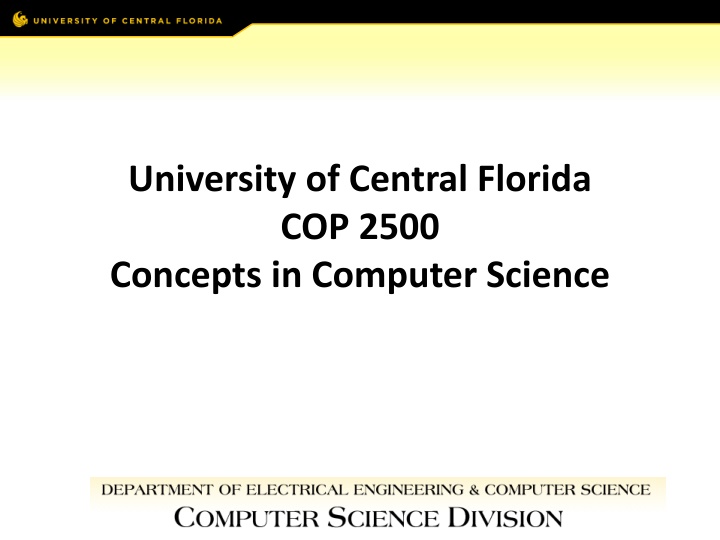
Exploring Concepts in Computer Science at University of Central Florida
"Discover important administrative details, class agenda, instructor information, teaching assistants, lab schedule, and user interaction with JavaScript in the COP 2500 Concepts in Computer Science course at the University of Central Florida. Learn about the interactive methods like dialog boxes, alerts, and prompts used for user engagement."
Download Presentation

Please find below an Image/Link to download the presentation.
The content on the website is provided AS IS for your information and personal use only. It may not be sold, licensed, or shared on other websites without obtaining consent from the author. If you encounter any issues during the download, it is possible that the publisher has removed the file from their server.
You are allowed to download the files provided on this website for personal or commercial use, subject to the condition that they are used lawfully. All files are the property of their respective owners.
The content on the website is provided AS IS for your information and personal use only. It may not be sold, licensed, or shared on other websites without obtaining consent from the author.
E N D
Presentation Transcript
University of Central Florida COP 2500 Concepts in Computer Science
Agenda Administrative information JavaScript lecture Dialog boxes / Alerts Comments
Instructor Instructor Josh Lazar Office location: By Appointment Office hours Tuesday and Thursday 6:00 7:00 PM by appointment Email: jlazar@labs.cs.ucf.edu
Teaching Assistants Teaching Assistants Name: Kumar Poojari Email: kumar.raghav@knights.ucf.edu Name: James Choi Email: jchoi2012@knights.ucf.edu
Lab Schedule Lab location: ENG1 O187 Section 11 Tuesday 2:30 P.M 3:45 P.M. Section 12 Tuesday 6:00 P.M 7:15 P.M. Section 13 Thursday 1:00 P.M. 2:15 P.M. Section 14 Thursday 2:30 P.M 3:45 P.M. Section 15 Thursday 6:00 P.M 7:15 P.M.
User Interaction With JavaScript Interaction with the user is accomplished using dialog boxes which are created via the methods alert() prompt() confirm()
alert() Used to send a warning to the user or alert them to some action Examples of usage Data not entered correctly Browser doesn t support a specific plug-in Debugging Creates an independent windows called dialog box Format alert( String of text ); alert(expression);
alert() Example output
alert() HTML is NOT rendered in a message string Can include escape sequences Format alert( String of text\n More text ); alert(expression);
prompt() Used to ask the user for information such as name, password, etc Prompt dialog box provides a single textfield box for input When user enters data, the value is returned prompt() method takes two arguments String of text displayed to the user String of text that is the initial default value for the dialog box
prompt() Format The value(s) in the parenthesis is an argument prompt(message); prompt(message, defaultText);
confirm() Used to confirm a user s answer to a question User must agree before the action is complete Examples include Online orders Bill payments Two options OK Cancel
confirm() Format Encapsulated in an if() statement if ( confirm( Do you want to continue? ) == true) { alert( You want to continue ); } else { alert( You don t want to continue ); }
JavaScript Comments /* This is a BLOCK COMMENT because you can have enter lines and as many lines as you want */ // This is an INLINE COMMENT because it is only for one line <!-- This is another format of the INLINE COMMENT -->
HTML Comments <!-- This is another format of the INLINE/BLOCK COMMENT works in HTML too -->
Questions Any questions?
